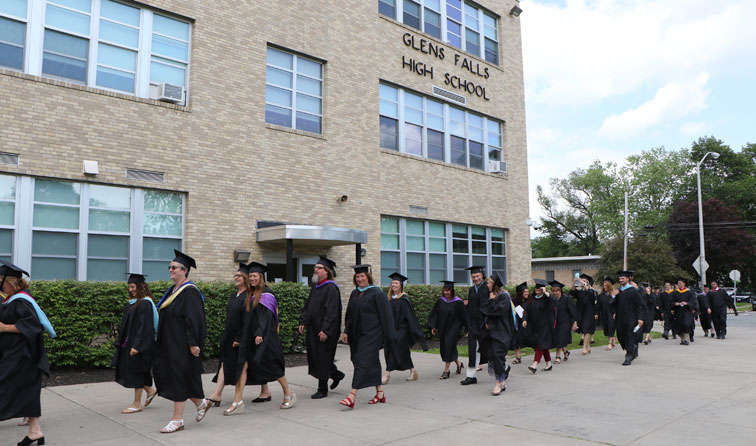
Like school districts across the state, Glens Falls City School District is using an evaluation procedure frequently referred to as “APPR,” which stands for “annual professional performance review.” These evaluations are required for all teachers and principals in New York State’s public school districts.
Glens Falls has always provided professional development, set specific goals, and evaluated faculty on a regular basis to ensure the district is providing a quality educational environment for students.
APPR Rating and Score release process
Pursuant to Education Law Section 3012-d, parents and legal guardians of students may request the final composite rating for each of the teachers and for the principal of the school building to which your child is assigned for the 2017-2018 school year. Please be advised that the law does not allow and prohibits the release of any additional information about the individual teacher beyond the final composite rating and transitional rating, if applicable. Only parents and legal guardians may have access to the final composite rating and transitional rating, if applicable, of the student’s teacher(s) and principal.
To request this information on your child’s educators, please follow the process as described below:
1) REQUEST FORM: The parent/guardian completes the form: “Parent/Guardian APPR Score Request Form,” and brings it—along with photo identification—to the main office of the child’s school. The parent/guardian’s photo ID will be copied onto the request form, and the form will be submitted for approval. No oral requests for APPR information will be honored, and parents/guardians should not expect to receive the information on the same day their written request is submitted.
The School District is required by the law to take reasonable steps to ensure that the person requesting the information is a parent or legal guardian of the student to whom the teacher(s) or principal is assigned. Therefore, any request must be in writing on the form provided. In the case of legal guardians, the School District will require proof of guardianship (e.g. court orders, etc.).
2) VERIFICATION: The district will verify that the information being requested is within the law. (Request must be made by a parent or guardian for a student in the current class or building of the teacher(s)/principal.) The status of the requesting person will be verified against other information concerning the student in the possession of the School District (e.g. information or documents submitted at the time of registration). The requesting parent/guardian will be notified once their request has been verified and approved, and an appointment with the administrator will be arranged.
3) FACE-TO-FACE MEETING: Once the request is approved, an appointment with the administrator, or designated individual authorized to release such information, will be arranged. At the meeting between the administrator and parent/guardian, the educator’s composite rating will be provided verbally. The parent/guardian will receive a document explaining the rating and score to best understand them in the context of teacher evaluation and student performance. (See “Understanding the Teacher & Principal Evaluation System“) Please note that the law does not allow the release of any additional information about the individual teacher/principal beyond the final composite rating.
Once the meeting is complete, the teacher or principal will be notified that his/her score was given out. Please note that a teacher or principal may appeal their final rating and composite score. This will impact the timing of when such information can be provided to a parent/guardian since, if an appeal is filed, the rating and composite score for that educator will not be available until that appeals process has concluded.
Requests for students to be placed with specific teachers will not be honored, in accordance with the district’s board-approved policy regarding student placement.
If you have any questions about this procedure, please contact the Superintendent of Schools at 518-792-1212.
Understanding the Teacher & Principal Evaluation System (APPR)
(courtesy of WSWHE BOCES)
Broad View of Evaluation
All classroom teacher and building principal evaluations are based on a combination of two components.
Evaluations have a component which measures professional practice: classroom practice for teachers or building-level leadership for principals. And evaluations have another component that measures student academic growth.
Performance in each component is built around the following performance levels, often referred to as HEDI: Highly Effective (exceeds expectations), Effective (meets expectations), Developing (needs improvement to meet expectations), and Ineffective (well below expectations).
The same is true for the final Composite Rating. When the two components are combined at the end of the year, each educator receives an overall rating of one of the four HEDI ratings.
There are many decisions along the way that are made through collective bargaining to make this meaningful for the local district.
Up-Close View of the Evaluation of Professional Practice
All teachers and principals will be observed at least twice per year. At least one of those observations needs to be an unannounced observation.
These observations will be completed by different observers, unless the district seeks a waiver from this requirement.
These observations are weighted differently, with the primary supervisor generally carrying the most weight.
The combined scoring of these observations is translated into a HEDI performance level, and is used as one of the two components in the Composite Rating.
Each district collectively bargains which rubric will be used to evaluate the educator, what aspects of professional practice will be evaluated, and how scoring will work within certain state-provided ranges.
All evaluators of teachers and principals are trained initially and recertified on a regular basis.
Up-Close View of the Evaluation of Student Academic Growth
All teachers and principals will have a portion of their evaluation based on how students are growing academically.
A state-provided growth score and/or Student Learning Objectives (SLOs) are used as tools in this process.
Teachers and principals who have students taking state assessments will still be evaluated on their students’ performance.
In order to provide flexibility to local districts and in many cases to reduce the overall amount of testing students are exposed to, SED allows for a wide variety of options to use in this component.
While SED is rewriting the ELA and math learning standards and their associated state assessments, no educator who is connected to the 3-8 testing will be evaluated based on student performance on these assessments.
Because of the transition to new 3-8 assessments, many educators will receive both an “Original” rating and a “Transition” rating.
Based on student assessment performance, a HEDI rating is generated, and is used as the other of the two components in the Composite Rating.
The assessments used in this component are either required by SED or chosen by the district.


